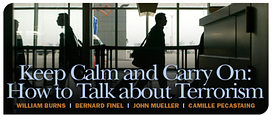President Obama in his inaugural address squarely acknowledges that our country is facing significant challenges at home and abroad. These challenges, whether they are from the threat of terrorism or the current financial crisis, have brought hardships to many people from all walks of life. We have for a time been knocked down. Even so, the president asks now that we get back up, that we brush our discouragement off and that we help to chart a new course for America, and by our example the world. It is with hope and virtue, he says, that we can and will face what storms may come. In essence, he asks that we be resilient in the face of our current troubles and future adversity. This is no easy request. It will require a sea change in our communication about risk.
Terrorism and times of crisis more generally produce a feeling of vulnerability which is born of uncertainty and lack of perceived control. Following some tragic occurrence we may feel deeply uncertain about what the event signals for the future. We may also wonder what can be done to protect ourselves. Feelings of fear, anger and anxiety are a usual response. These emotions become problematic when they cause us to focus almost exclusively on some dire consequence. This myopia will often cause us to ignore relevant probabilities and alternative consequences. With such narrow focus we have limited capacity to reason very far into the future. Instead we opt for policies with quick and decisive returns at the expense of more enduring long-term benefits. With this mindset we fail to develop resilience in the face of threat.
We can however, engage in risk dialogue that addresses our uncertainties and lack of perceived control directly. There are good reasons to do this. Increased understanding and sense of control lessens the tendency to focus narrowly on a single dire consequence. As a result, we tend to explore more options during personal decisions and policy deliberations. Such dialogue however requires that we identify public misperceptions surrounding such threats and construct risk messages to address these perceptual gaps. This is not easy, especially at the level of the national media. As Bernard Finel points out, the public tends to pay attention to sound bites, not nuanced conversation. However, it is possible to engage the public in meaningful dialogue at the community level where trust is high and attention span is much longer. Camille Pecastaing proposes that we begin such risk communication in our high schools. Tim Sellnow points out that we really need to develop three types of risk messages: pre-crisis messages that encourage mitigation of the impacts of potential events, during-crisis messages that minimize the impacts of an on-going event, and post-crisis messages that help restore confidence after an event.
We can also complement our risk communications with regulatory policy and contracts. Howard Kunreuther suggests that we develop policies that enforce regulations surrounding certain risks so as to overcome our tendency to ignore probabilities that fall below our threshold of concern (e.g. a mortgage crisis). He also advises that long-term contracts be used to overcome our bent toward near-term solutions (e.g. reluctance to invest in mitigation efforts to prevent large impacts in the future).
In my lead essay I suggest that with this new administration we are offered a choice in how we will respond to the threats of the future. Along our present course fear and anger will unduly influence our judgment and chart our way. Following our better history, as President Obama puts it, we will allow compassion and deliberative action to plot our course. Said another way, Rev. Sharon Watkins, in her post-inaugural sermon at the National Cathedral, warns that during this time of crisis we may be led away from our ethical center. It is though there are two wolves struggling within us, she remarks. The one represents anger, resentment, and fear and the other compassion, hope, and truth (taken from Cherokee lore). As we know the wolf that wins is the one we feed. This insightful story echoes the need for deep dialogue surrounding the threats we face. Those risk messages that we chronically attend to and come to internalize determine our collective response. We would do well to consider which wolf we are nurturing.

